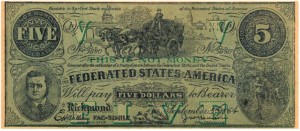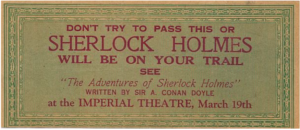A Scion Society of The Baker Street Irregulars

HolmeWork Assignment: The Imperial Theatre $5 Advertising Note
“We were to go to the theatre.”
– The Adventure of the Bruce-Partington Plans (BRUC)


In the late 19th and early 20th century, it was somewhat common to see advertisements on what seemed at first glance to be an old Confederate States of America banknote. Our next HolmeWork assignment is one of those examples and was brought to our attention by the 13th Garrideb, Peter E. Blau, in the February 2017 issue of Scuttlebutt from the Spermaceti Press.
Jennie Paton has found an interesting example of Sherlockian publicity: a facsimile five-dollar bill promoting “The Adventure of Sherlock Holmes” at the Imperial Theatre. We’d be delighted to hear from anyone who can identify when and where and why it was used.
It’s very possible that there are other examples of these notes for other versions of plays and productions of Sherlock Holmes. We have discussed before other scrip notes for other movies with a Sherlockian theme.
For those interested in researching this further, the website Cinema Treasures has a database of 91 theatres that are or were named the Imperial Theatre.

This has to be a cinema promotion! It was common for early cinemas to have promotions like these. And it must be for the Basil Rathbone film “The Adventures of Sherlock Holmes” (1939).
Perhaps the Imperial Theatre in Wappingers Falls, N.Y., a cinema, might be where it’s from. I’ll need to investigate further.
Howard, Thanks for the info. However, it looks like the Imperial in Wappingers Falls, NY didn’t open until 1966 per http://cinematreasures.org/theaters/12163.
Thanks Greg – the search continues then for which cinema and which “Adventures of Sherlock Holmes” too perhaps. Here are some things I’ve learned from inquires:
From Mike McClure: “It seems that Howard is narrowing in on the when and where of your question, so I will address the why. Following the U.S. Civil War (1861-1865) there were tons of worthless Confederate paper money remaining in existence. Many of these bills had originally been printed on only one side, so enterprising merchants were able to purchase them in large quantities and print business ads on the reverse side for about the same price as if they had used a blank sheet of paper. The designs caught the eye of potential customers who often threw away unwanted handbills. The limited supply of Confederate currency eventually ran out, but the promoters began printing up facsimile bills to retain their winning advertising campaigns. This note is clearly one of these later counterfeit confeds, complete with the “Fac-simile” stamp on the bottom. This practice gained popularity again during the centennial of the war years (1961-1965).”
From Peter Blau: “Could be the Rathbone film . . . which previewed in Hollywood on Aug. 19, 1939, and opened in New York on Sept. 1, 1939 . . . the promotion might be for a second release in 1940 or later. I’m not aware of a play with the title “The Adventures of Sherlock Holmes” earlier than the 1970s . . . there were film series with that title earlier than 1939 . . . I suspect it’s the Rathbone film, and perhaps someone will come up with confirmation . . . “
I’m going to be contrarian as I have a gut feeling that this is advertising a stage production and not a film.
If it was advertising the Rathbone film, I would think they would mention “starring Basil Rathbone,” and not “written by Arthur Conan Doyle.” Likewise, I would think whoever did the screenplay would be credited rather than ACD.
Imagine advertising “Gone with the Wind” as being written by Margaret Mitchell, rather than starring Clark Gable.
In 1939’s “The Hound of the Baskervilles” Basil Rathbone didn’t even get top billing, Richard Greene did. He wasn’t more famous than Conan Doyle was for Sherlock Holmes yet.